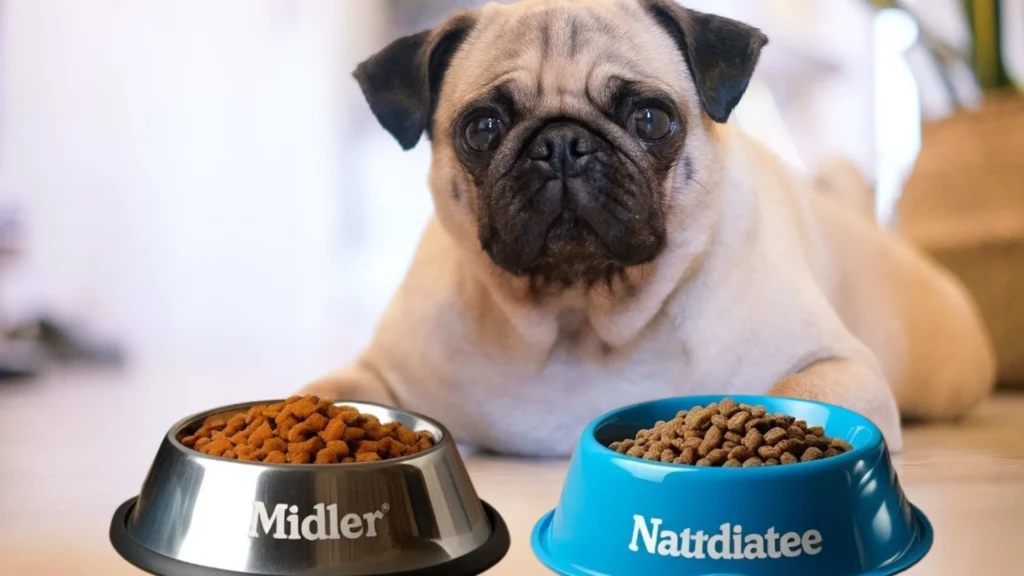I often get asked, “Can I mix 2 different dog foods?” It’s a question that many pet parents wonder about, and I totally get why.
After all, I want the best for my dog, just like you do. Mixing dog food can offer variety, but it’s important to approach it carefully.
I’ve learned that not all dog foods are the same, so combining them can have pros and cons. For example, it might improve taste or texture, but it could also cause digestive issues if not done right.
In this post, I’ll share my insights on mixing dog foods, and how to do it safely for your furry friend’s health and happiness.
Can I Mix 2 Different Dog Foods?
Yes, it is usually safe to mix different dry dog food brands or flavors. However, it’s always a good idea to check with your veterinarian first, particularly if your dog has a sensitive stomach, food allergies, or any underlying health issues.
Mixing foods can be a useful strategy for transitioning to a new diet, especially if your dog is a picky eater or has sensitivities. This gradual approach helps avoid digestive disturbances while offering variety and balance.
Why Do Dog Owners Mix Dog Foods?
Mixing dog food is something many pet owners consider for a variety of reasons. Some may want to provide their dog with different flavors, while others are trying to manage special dietary needs. Here are the common reasons why owners mix dog foods:
➤ Variety and Taste: Just like us, dogs can get bored of eating the same food every day. Mixing two different types of food can add variety, making mealtime more exciting.
➤ Nutritional Balance: Mixing foods may be a way to ensure that your dog is getting a balanced diet, especially if one food offers better protein while the other provides more fiber.
➤ Transitioning Between Foods: If you’re switching dog foods (for instance, moving from puppy food to adult food), mixing them gradually can help ease the transition.
➤ Managing Special Dietary Requirements: Some dogs need specific nutrients that may be found in different foods. Mixing foods can help meet those requirements.

Is It Okay To Mix Two Dog Foods?
Yes, it’s generally okay to mix two Dog foods, as long as both are nutritionally balanced and suitable for your dog. Mixing can be helpful for transitioning to a new food or providing variety, especially for picky eaters.
However, it’s best to do it gradually and monitor your dog for any signs of digestive issues. If your dog has specific health concerns, it’s always wise to consult your veterinarian before making any changes.
Can Dogs Eat Different Dog Food Everyday?
Yes, dogs can eat different dog foods every day, but it’s important to do so thoughtfully. While some dogs enjoy variety, frequent changes in diet can lead to digestive issues like diarrhea or vomiting, especially if the transition isn’t gradual .
To minimize risks, introduce new foods slowly over 7–10 days and monitor your dog for any adverse reactions.
If your dog has food sensitivities or allergies, it’s best to consult your veterinarian before making dietary changes. Ultimately, whether to offer variety should be based on your dog’s individual health needs and preferences.
How To Mix Two Different Dog Foods Safely
If you decide to mix two different types of dog food, follow these simple steps to ensure it’s done correctly and safely:
Step 1: Choose High-Quality Dog Foods
Choose high-quality dog foods that are appropriate for your dog’s age, size, and health condition. Avoid mixing low-quality foods that may be filled with artificial preservatives, fillers, or low-grade ingredients.
Step 2: Gradual Introduction
Start by mixing a small amount of the new food with the old food. Gradually increase the new food and decrease the old food over 7 to 10 days. This will help your dog’s digestive system adjust.
Step 3: Monitor Your Dog’s Health
During the transition, closely monitor your dog’s weight, stool consistency, energy levels, and overall health. If any unusual symptoms arise, it may indicate that the food combination is not suitable.
Step 4: Consult Your Veterinarian
If you are unsure whether mixing two dog foods is appropriate for your dog, always consult your veterinarian. They can guide you on the right foods for your dog’s specific needs and ensure the mix will not interfere with any underlying health conditions.
Benefits Of Mixing Two Different Dog Foods
Mixing two different dog foods can offer several benefits for your pet. It provides variety, making meals more interesting and enjoyable for your dog.
Combining dry and wet foods, for example, can enhance the texture and taste. It also allows you to offer a more balanced diet by combining different nutritional profiles.
This mix can address specific health needs, such as weight management or digestion. Additionally, rotating between foods may help prevent food sensitivities or allergies.
However, it’s important to monitor how your dog reacts to the mix to ensure it’s a good fit for their health.
Risks Of Mixing Two Different Dog Foods
1. Unbalanced Diet
If the two types of food are not complementary, mixing them could lead to an unbalanced diet, which may result in nutritional deficiencies or excesses. It’s important to ensure that both foods meet your dog’s nutritional requirements.
2. Digestive Issues
Some dogs may have a sensitive stomach that cannot handle mixed foods, leading to diarrhea, bloating, or vomiting. Start by mixing small amounts and observe your dog’s reaction. If any signs of digestive upset occur, consider stopping the mixture.
3. Overfeeding or Under nutrition
Not all dog foods have the same caloric density. Mixing high-calorie foods with lower-calorie ones can cause overfeeding, leading to weight gain. Conversely, mixing foods that are too low in calories may lead to under nutrition. Balance is key when mixing dog foods.
Frequently Asked Questions
Can I mix wet and dry dog food daily?
Yes, combining wet and dry dog food can enhance palatability and provide a balanced mix of moisture and nutrition. Dry food is cost-effective and helps clean teeth, while wet food is more enticing and provides additional moisture. However, ensure proper storage and monitor your dog’s response to avoid digestive issues.
How should I transition between different dog foods?
Gradually mix the new food with the old over 7–10 days, starting with a small amount of the new food and increasing it daily. This gradual transition helps prevent digestive upset and allows your dog to adjust to the new diet.
Is it safe to mix dog foods of different brands?
Mixing different brands can be safe if both foods meet AAFCO standards and are appropriate for your dog’s age, size, and health condition. Ensure that the combined foods provide balanced nutrition and consult your veterinarian if unsure.
Can I mix dog food with homemade meals?
Yes, you can mix dog food with homemade meals, but it’s crucial to ensure the homemade portion is nutritionally balanced. Consult with a veterinary nutritionist to create a diet plan that meets your dog’s specific needs.
How often can I change my dog’s food?
It’s generally safe to rotate your dog’s food every 2–6 months to provide variety and prevent food sensitivities. However, always monitor your dog’s health and consult your veterinarian before making significant dietary changes.
Conclusion
Incorporating variety into your dog’s diet by offering different dog foods can be beneficial, provided it’s done thoughtfully.
Gradually introducing new foods, monitoring your dog’s response, and consulting with your veterinarian are key steps to ensure a healthy and enjoyable feeding routine.
Remember, each dog is unique, so tailoring their diet to their specific needs and preferences is essential for their well-being.

Hello dog lovers, I am John. Welcome to my website healthydogfoods.com. I am happy to gain experience from my love for my dog and my pet dog. Through my experience and acquaintance with dog veterinarians, I have made myself a proper guide for dogs. I will tell you about dog care, their nutritious food, their proper safety and dog upbringing for a better life. Even though dogs cannot talk like humans, I will solve all the problems by observing their behavior. I will discuss the proper care and related issues of your dog. Which will give you the right answer to all the problems of your beloved dog.